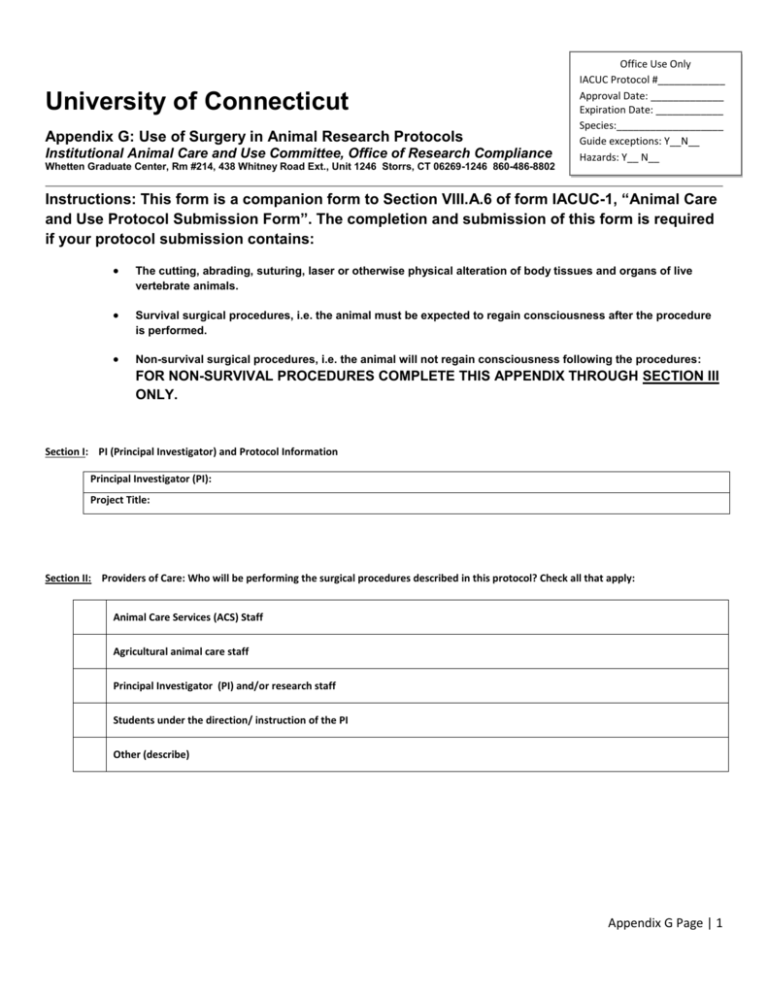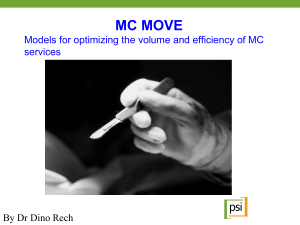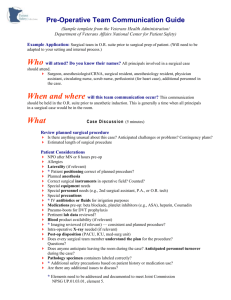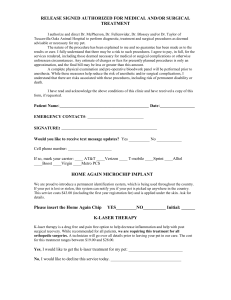University of Connecticut Appendix G: Use of Surgery in Animal
advertisement

University of Connecticut Appendix G: Use of Surgery in Animal Research Protocols Institutional Animal Care and Use Committee, Office of Research Compliance Whetten Graduate Center, Rm #214, 438 Whitney Road Ext., Unit 1246 Storrs, CT 06269-1246 860-486-8802 Office Use Only IACUC Protocol #____________ Approval Date: _____________ Expiration Date: ____________ Species:___________________ Guide exceptions: Y__N__ Hazards: Y__ N__ Hazards: Y___ N___ Instructions: This form is a companion form to Section VIII.A.6 of form IACUC-1, “Animal Care and Use Protocol Submission Form”. The completion and submission of this form is required if your protocol submission contains: The cutting, abrading, suturing, laser or otherwise physical alteration of body tissues and organs of live vertebrate animals. Survival surgical procedures, i.e. the animal must be expected to regain consciousness after the procedure is performed. Non-survival surgical procedures, i.e. the animal will not regain consciousness following the procedures: FOR NON-SURVIVAL PROCEDURES COMPLETE THIS APPENDIX THROUGH SECTION III ONLY. Section I: PI (Principal Investigator) and Protocol Information Principal Investigator (PI): Project Title: Section II: Providers of Care: Who will be performing the surgical procedures described in this protocol? Check all that apply: Animal Care Services (ACS) Staff Agricultural animal care staff Principal Investigator (PI) and/or research staff Students under the direction/ instruction of the PI Other (describe) Appendix G Page | 1 Section III: Identification of NON-SURVIVAL Surgical Procedures A. Describe non-survival surgery below, including methods of anesthesia, checking for depth of anesthesia, and surgical preparation and procedures. (n.b., the Guide 2011 states that for non-survival surgeries, at a minimum, the surgical site should be clipped, the surgeon should wear gloves and the instruments and surrounding areas should be clean). ► Section IV: Identification of SURVIVAL Surgical Procedures A. Minor surgical Procedures: Minor surgical procedures are surgical procedures that do not expose a body cavity AND that cause minimal or no physical impairment 1. Will any minor surgical procedures be performed in this protocol? No B. Yes (qualify below) a. Identify all minor surgical procedures used in this protocol: ► b. Which species will receive these procedures? ► c. What is the purpose of the procedures identified (briefly describe in layman’s terms)? ► Major surgical procedures: Major surgical procedures are surgical procedures that expose a body cavity AND/OR cause substantial physical or physiological impairment 1. Will any major surgical procedures be performed in this protocol? No Yes (qualify below) a. Identify all major surgical procedures used in this protocol: ► b. Which species will receive these procedures? ► c. What is the purpose of the procedures identified (briefly describe in layman’s terms)? ► Section V: Surgical Preparation: Answer the following questions related to all survival surgery procedures identified in Section IV: A. Preparation of surgical location: 1. Where will the surgery or surgeries be performed? Specific location(s): ► 2. Is this location a dedicated surgical suite? 3. How will this location be prepped for the surgery (surfaces cleaned, disinfected, or sanitized; surfaces reorganized to accommodate surgery, dedicated hood prepped with UV light, etc.): Yes No ► Appendix G Page | 2 4. Animal preparation a. Will animal preparation require fasting or fluid restriction? ► No Yes How long? b. Will animal preparation include use of a pre-anesthetic or early administration of analgesia? Yes c. Are any additional animal preparations necessary? No ► 5. 6. Surgical instrument preparation a. How will surgical instruments be prepped for surgery? ► b. How will sterility or asepsis of surgical instruments be maintained the surgery? ► throughout the course of Surgical site preparation: a. How will the surgical site be prepped for surgery? ► Section VI: Conduction of Surgery A. Anesthesia: Complete the following questions regarding the use of anesthesia for surgical procedures described in this protocol. 1. Will any surgical procedures be performed without anesthesia? No Yes, if Yes, justification MUST be provided below: ► 2. Species Please complete the following regarding any primary and secondary surgical anesthesia that will be used for this protocol: Timing of General or Route of administration (preSurgical Procedure Anesthetic used local Dose administration surgery, during anesthetic? surgery, etc.) 3. For any general anesthetics listed above, please indicate how depth of anesthesia will be monitored (check all that apply- at least 2 methods must be checked for surgery that requires a surgical plane. One method is acceptable for surgery requiring the numbing of an area) Blood pressure/ EKG readings Corneal reflexes Respiratory rate Tail/toe pinch (pedal reflexes) Appendix G Page | 3 EEG Heart Rate Pinching or pricking of incision site (local anesthesia only) B. NMB: Neuromuscular Blocking Agents 1. C. Other: specify Other: specify Will any neuromuscular blocking agents, muscle relaxants, or paralytic drugs be used in this protocol? Yes (qualify below) No a. What species will receive the agent(s)? ► b. What drug and dosage? ► c. How will respiration and anesthesia depth be monitored while animals are under the influence of these agents? ► Surgical techniques 1. Describe, in detail, the procedures for any minor surgical techniques identified in Section IV, or provide copy of SOP (or reference to IACUC approved SOP#). If more than one species is used in the protocol, indicate which one(s) are undergoing the procedure: ► 2. Describe, in detail, the procedures for any major surgical techniques identified in Section IV, or provide copy of SOP (or reference to IACUC approved SOP#). If more than one species is used in the protocol, indicate which one(s) are undergoing the procedure: ► 3. Describe any types of sutures, wound clips, staples, glue, or other tissue closure method that will be used: ► 4. How will bleeding be controlled during surgery? ► Section VII: Medications A. Withholding Analgesia: Complete the following regarding the use of analgesia for this protocol: 1. Will any animals have analgesic use withheld for surgical procedures? No Yes, if Yes: a. What species and procedures? ► b. What is the justification for withholding analgesia? ► c. What non-analgesic measures will be taken to alleviate pain or ► B. discomfort? Administration of medications: Appendix G Page | 4 1. Species Please complete the following table regarding medications that will be administered to animals due to surgical procedures for this protocol (examples include analgesics, antibiotics, anti-rejection drugs, fluids, etc.): Surgical Procedure Medication used Dose Route of administration Timing of administration (presurgery, during surgery, postsurgical, perisurgical) Frequency and duration of reapplication 3. If medication other than analgesia or antibiotic, please describe its purpose and function: ► Section VIII: Recovery A. Post-operative monitoring 1. Who will provide immediate post-operative care and observation to the animals? 2. Will animals be provided a warming blanket or other heat source to aid recovery from anesthesia? ► 3. How often will animals be checked, and by whom, prior to fully awakening? ► 4. Will animals require any specialized post-operative care? Describe: ► ► 5. Where will post-operative recovery occur? ► B. Return to regular housing 1. What are the criteria for determining an animal is ready to be returned to a regular housing facility (or otherwise released back into its environment)? ► 2. Will animal require any housing or environmental modifications upon its return? (e.g. single housing, dietary supplement, food placed on floor of cage, etc.) Describe: ► 3. Will animal require sutures or staples to be removed? No Yes, if Yes: When, and by whom: ► Appendix G Page | 5 C. Surgical Impairment 1. Describe the anatomical and/or physiological effects the surgery is expected to have on the animals: ► D. Post-surgical maintenance of animals 1. E. Will the effects described above require any long-term maintenance or monitoring of the animals’ condition, or will procedures decrease the animal’s normal lifespan? No Yes, if Yes, describe: ► Surgical Complications 1. What are the anticipated and potential surgical complications that may be seen with the surgical procedures outlined in this protocol, and what is the plan for dealing with these complications should they arise? ► 2. What is the expected animal attrition due to surgical complications for this procedure when it is performed by a skilled individual? Ensure that attrition has been considered in the numbers justification section of the main protocol form. ► 3. Can any of the surgical procedures utilized by this protocol be described as unfamiliar, novel, or infrequently used [by personnel in your laboratory]? No Yes, if Yes, briefly describe training that will be provided to acclimate research associates: ► Section IX: Multiple Major Survival Surgery A. Will any animals identified in this document be receiving a second (or more) major survival surgery during the course of this protocol? No Yes, if “Yes”: 1. What is the nature of the two (or more) major survival surgeries? ► 2. Why are multiple surgeries necessary for meeting the research goals and objectives? (Scientific or animal welfarerelated justification is required for this response) ► Appendix G Page | 6







